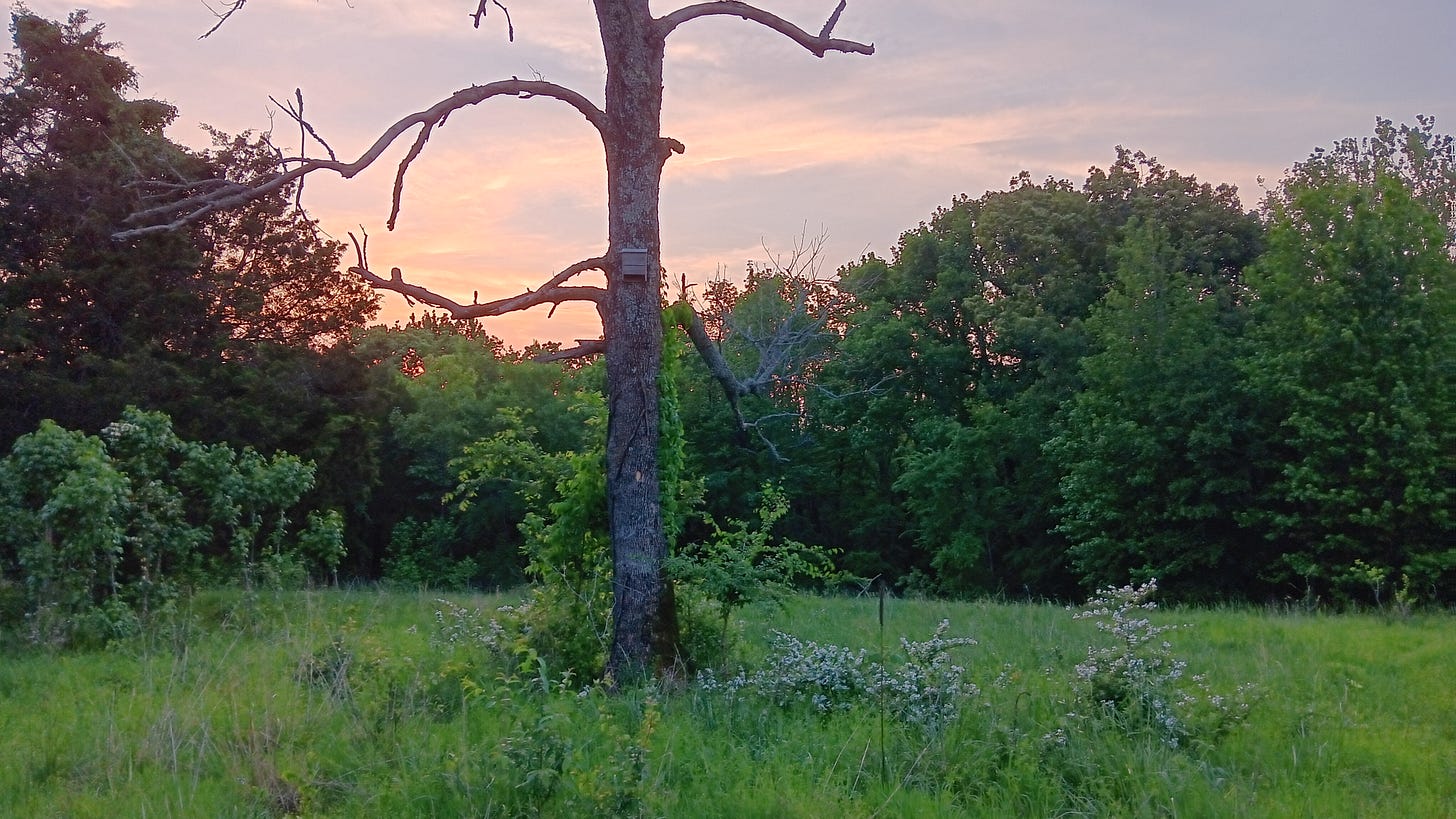A Quick Update & Some Exciting News:
Welcome back to Fox Hollow. Spring is officially in full swing with consistent rain and unpredictable “you gotta wear layers because you get all four seasons in one day” kind of weather. I’m excited to announce a slight adjustment to farm update posts that I think you will enjoy. Starting now, in May, I’ll create a letter for each month which will include any/all of these:
Updates from the farm
Garden and farm chores for you to consider in the coming month
Art updates, sketchbook pages, and/or plant index pages
Community Corner, featuring a local event or local maker, farmer, gardener, etc.
A monthly free resource or tip I’ve found useful or meaningful
Some actionable ideas for you to take away
Paid subscribers will also receive a piece of surprise snail mail, delivered periodically to your doorstep (or P.O. Box). I’ll send another letter to paid subscribers with more about this soon.
On a separate note, I have seen a lot of discourse lately about em dashes and bulleted lists being a sign of using AI. I love em dashes and lists, but I assure you I do not use AI to write these posts, I just appreciate order and a necessary pause— in case you wondered.
If you love this post but don’t want to commit to a paid subscription, you can support my work by “buying me a coffee” by clicking the button above. Proceeds will go directly into the farm, always. One million thank-yous for your support, monetary or otherwise.
Cool, wet prairie grasses have grown thick and lush along paths in the backyard and throughout the field. I noticed hundreds of bloomed or half-bloomed wild bergamot flowers arranged sporadically across the forest floor on a walk to the creek the other day. Lately I’ve been enjoying my morning cup of coffee while watching birds outside sliding glass doors that face the backyard. Bright red cardinals with their mates, house finches, wrens, bluebirds, crows, nuthatches, and more dart between oak branches and scour the ground for bugs and seeds. “It’s like a wildlife preserve out there,” I thought to myself a few mornings ago.

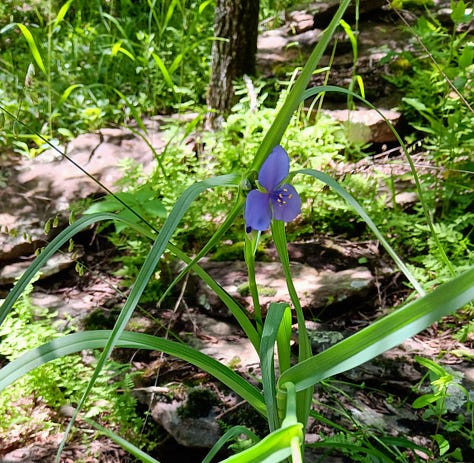
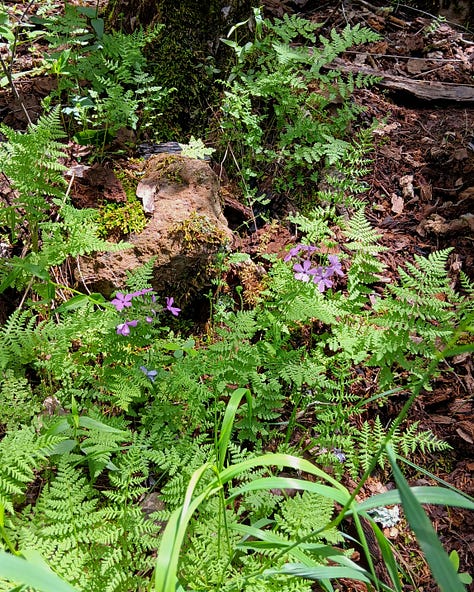
Our little wildlife preserve has been teeming with life since spring began reaching its tendrils across the landscape. If you could see the camera roll on my phone, you’d see nothing but green plants waiting to be identified, save a few cat photos. Perennials are re-emerging from their winter slumber: coneflower, wild bergamot, brown-eyed susans, passionflower vine, wild blackberries, wild phlox, carolina larkspur, yarrow, ironweed, and swamp thistle to name just a few. The arrival of this spectacular flora and fauna is a reminder of the fierce and powerful energy of spring.
Slowing the Pace
I’ve been feeling this fierceness lately too. Over the past couple months, I’ve become busy with my day job, the farm, the news, obligations, and generally just trying to keep my head above water. When this happens to me there is always a moment, a climax of heightened energy and overwhelm, that tends to hit me all at once with a sudden realization that I need to slow down. That crescendo happened recently, so I’m trying to take it seriously. Slowing down feels natural, even unavoidable during the darker months. Early sunsets force me to go inside and wind down at a reasonable hour, ensuring plenty of rest and relaxation. The onset of spring, however, brings endless activities that I want to participate in: gardening, farm chores, get-togethers, hikes, and travel. The sun sets later each day, luring me outside to dawdle until almost 9 o’clock.
You will be completely shocked to know that I can’t actually do it all, no matter how much I want to. Last weekend was the first weekend I spent mostly at home in a while. Damien and I did things at our own pace as we felt the pull— we made food, worked in the garden, tended to the chickens, fixed some things that needed fixing, and spent some much-needed quality time together. It was a slow weekend that felt like a nap on a warm summer afternoon at your grandmother’s house as a child, much needed and deeply comforting.
Chores for Early to Mid-Spring
Gardening and farm work are among the things that can’t really be shelved for later. They don’t slow down, in fact, they speed up rapidly during spring. This is fine with me because I love this work more than most things. I mean, I love doing it at my own pace, which our style of farming lends itself to. Slowly building better soil, slowly moving the chickens around the land, slowly pulling weeds, and waiting for plants to grow.

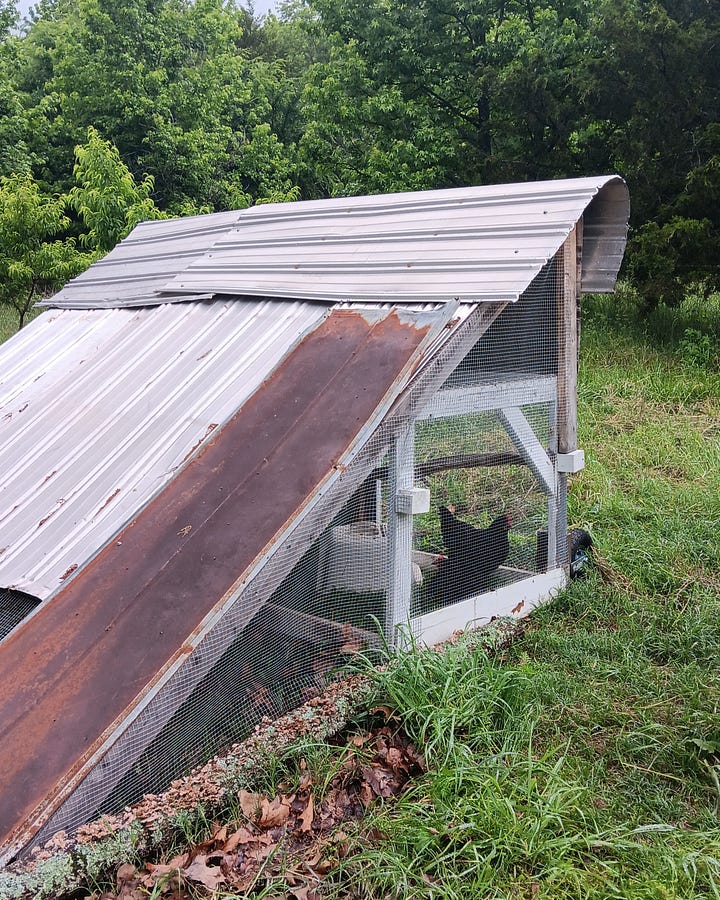
So far this spring, we have begun the next step in preparing new beds and amending established ones by sowing cover crops, terminating fully grown cover crops, adding chicken manure, compost, and mulch. We have also grown annual seedlings under grow lights and have recently acclimated them to the outdoors. These include mostly tomatoes, sweet potatoes, and peppers along with some frost-sensitive herbs and flowers. Soon, we will transplant all of these seedlings into the garden. I like to wait until the second week of May if possible because my grandmother (Nani) always says to wait until after Mother’s Day to be clear of cold spells.
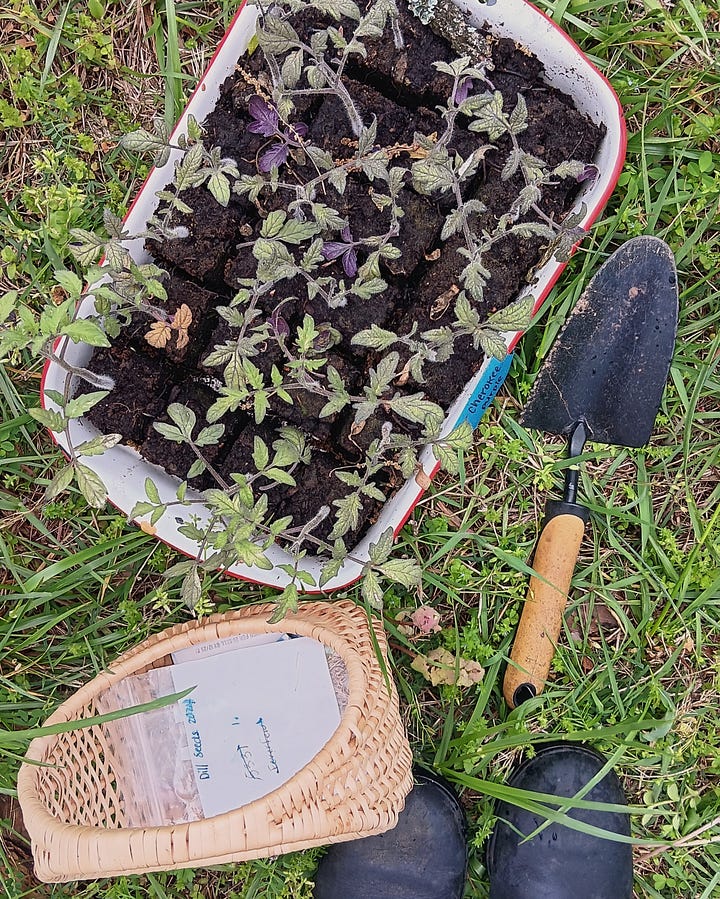
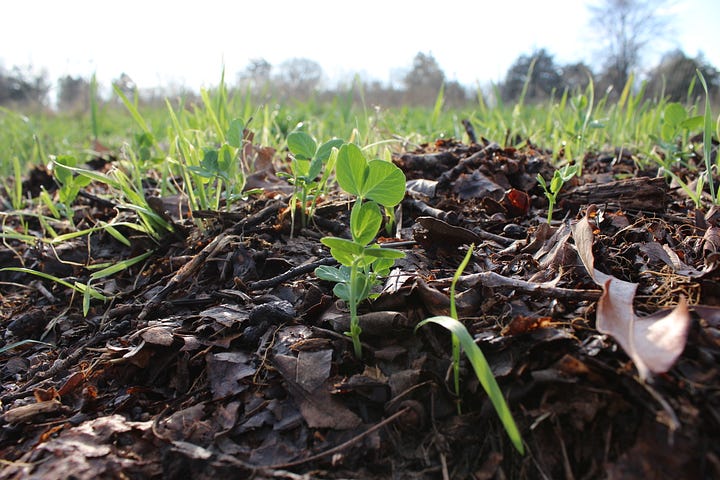
Earlier in March and April, I direct-sowed several things in the garden beds: nasturtiums, radishes, dill, chamomile, calendula, lettuce, kale, and certainly others I can’t recall. They are coming up now, growing stronger with each day growing longer and warmer. In my area, early May is the all-clear for direct sowing everything you haven’t already sown. Some other early to mid-spring jobs we’ve been working on and some we have already completed are:
Direct sowing seeds for herbs and flowers, specifically chamomile, marigolds, and calendula.
Weeding and adding compost and mulch where it’s needed
Building up the dirt around our potatoes as they grow, aka “hilling” them
Re-sowing more brassicas like radishes and kale
Harvesting greens and brassicas before they bolt
Building trellises for vining plants like peas, beans, cucumbers, tomatoes, etc. We use fallen sticks tied or nailed together for the most part. I need to build a nice, big trellis for some wild grape I spotted in a front flowerbed too, but I haven’t gotten around to that just yet. It’s on the list.
Planting asparagus — We are always working to expand our perennial plant repertoire so that we lessen input of materials and minimize the amount of labor we need to put into our garden. We finally decided order asparagus crowns and dedicate a growing spot to it… for the next decade or two! We planted some companions with the asparagus: tomatoes, dill, and marigolds.
Chores for June
While I enjoy reflecting on and sharing what we’ve been working on throughout the month of this update post, what help would it be to you, readers/gardeners/makers, if I didn’t share ideas for what to do to prepare for the coming month? June is approaching, a season of sharp contrast to early spring. If you live in a climate similar to mine (northeast Oklahoma in zone 7), here are some chores to start thinking about for early summer:
Continue direct succession sowing warm-season flowers and herbs such as basil, parsley, dill, nasturtiums, marigolds, sunflowers, and zinnas. Direct sow any warm weather crops you haven’t already.
Around here, June is the beginning of pest season. It is a time in which plants, especially annuals, are highly susceptible to diseases like blossom end rot or powdery mildew. I always try to make sure leaves aren’t lying on the ground as much as possible to ensure good ventilation, especially with very leafy, vining plants like tomatoes.
Speaking of pests, keep an eye out in early summer for pests that are easy to hand-pick like squash bugs. As your garden increases in biodiversity, the natural predators of pests like aphids, white flies, and more will help protect your plants. I’ve seen several garden spiders and lady beetles already at work in ours. However, sometimes the pest pressure grows quickly and you may want to hand pick by pinching them off and trying to keep them under control early.
Continue building soil by sowing warm weather cover crops like buckwheat or sorghum grass.
Keep harvesting greens before they bolt. You may also consider letting your best plants go to seed so that you can collect seeds for next year.
Continue weeding invasive grass or weeds if they begin to crowd your crops.
Pinch off flowers from herbs like mint, oregano, basil, etc. to encourage a bushier plant and avoid seed distribution of spreading herbs.
You may want to add compost around flowering plants since flowering requires lots of energy.
Deadhead spent flowers to encourage more blooms.
Since they’ve finished flowering, June can be a good time to take cuttings from softwood shrubs like lilacs and viburnums.
Watch to see what wild plants emerge in June. Here in the Ozarks, I expect to see wild passionflower vine, fully developed blackberries, and orange milkweed in full force throughout the next month or so.
I can’t wait to see how our garden (and yours) progresses throughout the rest of May and into summer.
Community Corner
This is the first ever “community corner” in which I will share some goings-on from my local community, sometimes telling you about a community-building event or perhaps a person doing good work in the community. I hope you enjoy this new section of my monthly updates.
Earth day, April 22, was the day Damien’s debut book of poetry was officially released (if you’re new here, Damien is my partner/love of my life). Published by the local and prolific Belle Point Press, his book is called “Birds I Cannot Name” and it is a culmination of poems he’s spent many years crafting, curating, and synthesizing into this finalized work of art.
On a recent weekend, we attended a local poetry reading at which Damien was the featured reader. There were lots of talented poets and writers there who shared their work, and I even finally met a fellow local farmer in person after following each other’s social media profiles for a long time (Hi, Nina! It was really great meeting you). It was beautiful to watch Damien read the work he has poured his heart and soul into for years to a group of friends, family, and strangers, and to watch most of them experience it for the first time. His sister, my sister-in-law and dear friend, sat beside me during the reading and at one point after Damien read a poem’s title, she whispered “this one’s my favorite”. It was very special and I feel very sappy about it.
Another bit of local flavor, the annual Stilwell Strawberry Festival, happens the second weekend in May. We look forward to this festival each year which takes place in the strawberry capital of the world, not too far from us. There will be a parade, strawberry princess, prince, queen, and king (all adorable kiddos) riding on floats (or their dad’s pickup truck), local vendors and food, and LOTS of fresh strawberries to eat. There aren’t many local events as delightful as a festival surrounding the harvest of a single crop. At the same time the strawberry festival is ramping up, our own strawberry patch continues to provide us with buckets of fresh fruit.

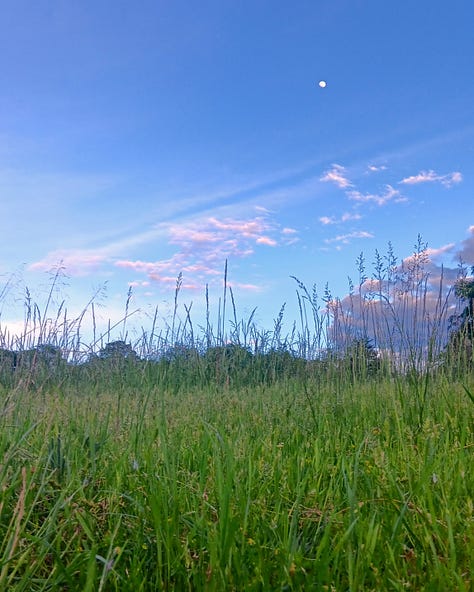
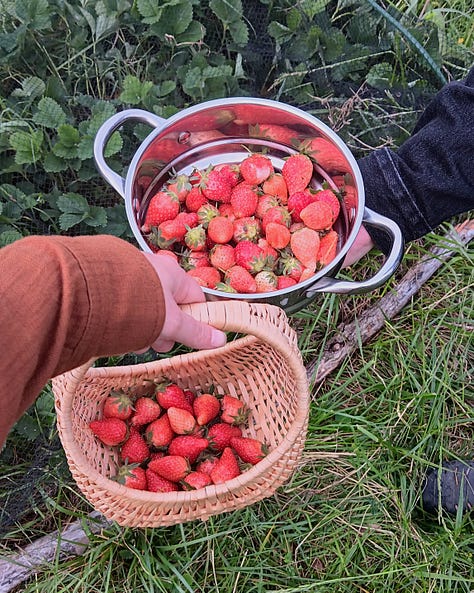
It is sometimes difficult for an introvert who lives miles outside of town and has a full-time job to build community, but I’m trying. Events like this one fill me with so much inspiration and optimism.
Your Monthly Resource(s)
Going forward, in monthly update posts, I will share with you at least one valuable resource. It may be an essay, a book, a tool, or any number of things that may contribute homesteading or general know-how.
Check out Damien’s book, Birds I Cannot Name, from Belle Point Press. As one of the reviews describes: “Part ritual, part reclaiming of self, the poems in Birds I Cannot Name offer up a chorus of voices in sometimes discordant harmony. Beginning in the Oklahoma Ozarks and migrating toward the Pacific Northwest, this debut collection sings with reverence for the natural world while reckoning with the limits of human community. Damien Uriah crafts a vision of a landscape rooted in liminal spaces that feels deeply mysterious yet mystically familiar.”
- who created has a wealth of knowledge and insights about growing food, agroecology, and more. His essay from earlier this year, “Homesteading with a Planet on Fire,” is poignant and deeply relevant. It is free to read on his substack or you can listen to it for free on most podcast streaming platforms.
Spring Shifts into Summer
Days at the creek, weekends spent camping at the lake, grill-out nights, and long porch sits with a cold beverage are all just over the horizon, but there are still special spring moments to savor before the Ozark heat settles in. For instance, our fruit trees are producing in their third year of growth. I’m remaining cautiously optimistic about a harvest of peaches, plums, and pears and meanwhile clipping off too-heavy fruit from too-weak branches. Until the blackberries ripen, take care of yourself and your community. It’s some of the most pertinent, most necessary work to be done.
I sincerely hope you have enjoyed this farm update and have found it useful in some way. If you want to receive a quarterly piece of snail mail from yours truly, you can sign up to be a paid subscriber for about the price of an iced latte per month. If you don’t, or can’t, I am equally thrilled for you to be here, reading my work and supporting what I do.
Thank you for being here.
Warmly,
Allyson
If you’re new here, hi! I’m Allyson. My partner and I have a small farm where we practice agroecology, grow food, raise animals, make art, and continually work toward creating healthy soil and healthier lives. Aside from farming, I’m a visual artist who enjoys writing and my partner, Damien Uriah, is an accomplished, published poet and musician.
Our goal is to share updates from an agroecology-focused farm run by two creatives with day jobs, show how you can grow food without devastating ecosystems (while acknowledging that big change needs to happen from the top), help people learn about food, flora, and fauna, and to create a wealth of community knowledge with others.
I hope you’ll stick around and subscribe (free and paid options) and grow with us.
If you love this post but don’t want to commit to a paid subscription, you can support my work by “buying me a coffee” by clicking the button above. Proceeds will go directly into the farm, always. One million thank-yous for your support, monetary or otherwise.





